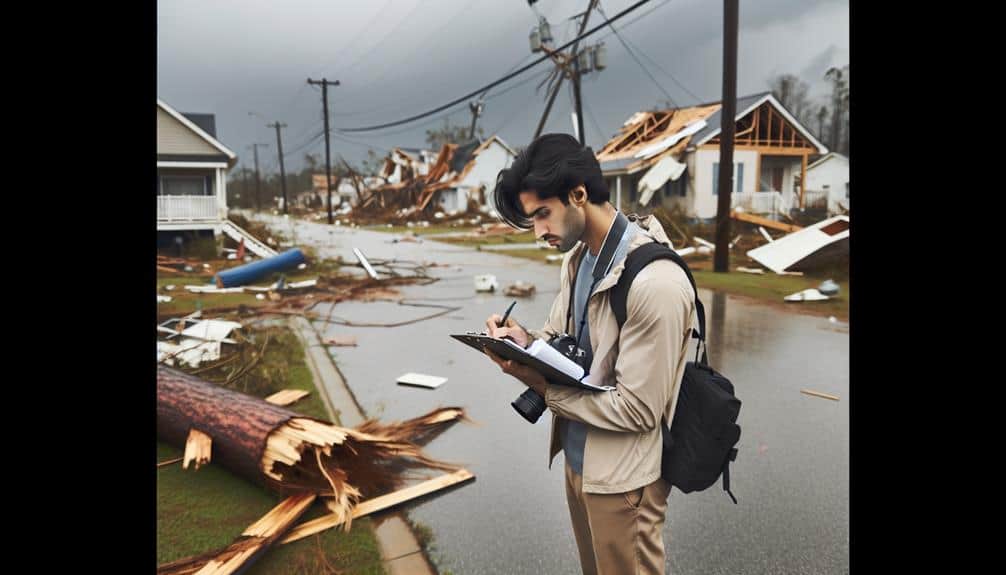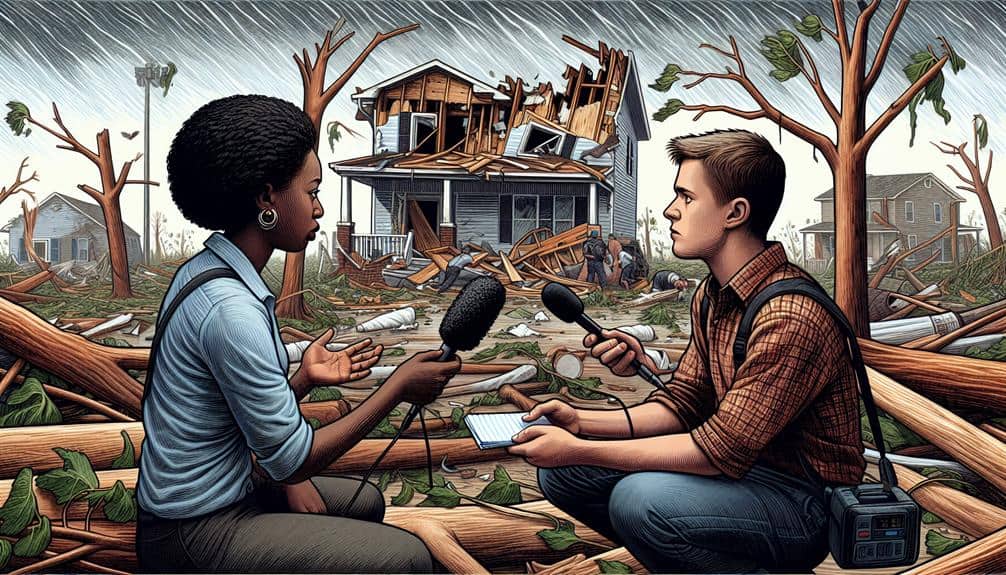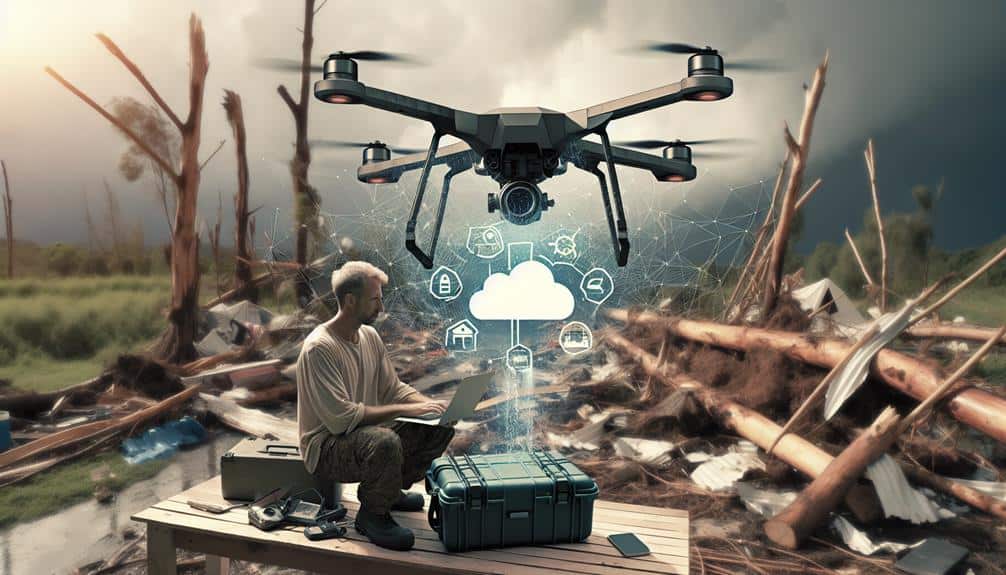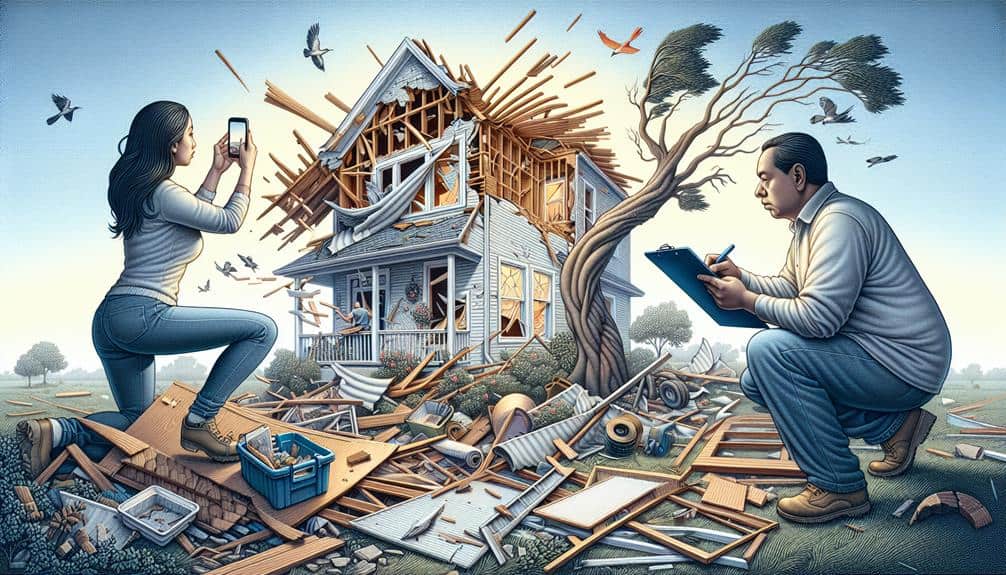Effective documentation of storm devastation requires us to prepare our equipment by ensuring it's fully charged, functional, and weather-resistant. Capture high-resolution photos and record videos under ideal lighting to emphasize key damage. Detailed note-taking, including timestamps and GPS coordinates, is essential for accuracy. Interview witnesses and prioritize safety by avoiding hazardous areas. Secure robust data storage and backup solutions to safeguard valuable information. Share findings responsibly, anonymizing personal information and balancing transparency with sensitivity to evoke empathy, not distress. Following these tips will help us document storm devastation thoroughly and ethically, providing deeper insights and impactful stories.
Key Points
- Use high-quality cameras and varied lenses to capture detailed and versatile images.
- Organize notes systematically by location and damage type for clarity.
- Capture wide-angle shots and key damage areas to provide comprehensive visual documentation.
- Note timestamps and specific locations for each observation to ensure accuracy.
Prepare Your Equipment
Before heading out to document storm devastation, we must make sure all our equipment is fully charged, functional, and ready for use. This includes cameras, drones, and mobile devices. Equipment maintenance is vital. We should inspect each item for any signs of wear and tear, making sure that lenses are clean, batteries are charged, and memory cards have sufficient space. It's important to pack extra batteries and memory cards to avoid any interruptions in the field.
Storm safety is our priority. We need to confirm that our equipment is weather-resistant or protected by appropriate covers to withstand harsh conditions. It's equally important to update our technology regularly. Firmware updates can enhance performance and provide new features that could be invaluable in the field. Staying informed about the latest advancements helps us adapt to any situation we might encounter.
Field conditions can be unpredictable, so our gear must be versatile and reliable. We should have a checklist to ensure no critical item is forgotten. By meticulously preparing our equipment, we can focus on capturing the true extent of storm devastation, empowering communities with vital, reliable documentation.
This preparation allows us to work efficiently and safely, embodying the freedom to tell impactful stories.
Capture High-Resolution Photos
When we capture high-resolution photos, we need to prioritize ideal lighting conditions to guarantee clarity.
It's essential to focus on key areas most impacted by the storm, providing a detailed visual account.
Using proper equipment, such as a high-quality camera, helps us document the devastation with the level of detail needed for thorough reporting.
Optimal Lighting Conditions
To capture high-resolution photos of storm devastation, we need to prioritize ideal lighting conditions, ideally shooting during the golden hours of early morning or late afternoon. These times offer softer, more diffused light, reducing harsh shadows and providing a balanced exposure that enhances the details of the scene. In the context of natural disasters, this approach allows us to document the extent of damage with clarity and precision.
Using effective photography techniques, we can leverage this best lighting to highlight the textures and intricacies of the wreckage. The interplay of light and shadow during these hours adds depth to our images, transforming them into compelling visual stories. When we shoot under these conditions, we also minimize the risk of overexposure, which can obscure critical details imperative for accurate documentation.
Moreover, capturing photos during the golden hours often results in less crowded scenes, allowing us to focus on the devastation without the interference of unnecessary elements. This method not only improves the technical quality of our images but also optimizes that they convey the gravity of the situation. By prioritizing these best lighting conditions, we enhance our ability to tell powerful, truthful stories through our photography.
Focus on Key Areas
We must concentrate on photographing the most impacted areas to guarantee our high-resolution images accurately convey the true extent of the storm's devastation. By focusing on key areas, we capture the critical moments where weather patterns have left their most profound marks. These images serve as compelling evidence of environmental impact and provide a visual narrative that can drive disaster relief efforts.
First, let's document residential zones where homes and personal belongings are destroyed. These areas often evoke the strongest emotional responses and highlight the immediate needs of the affected community.
Next, we should photograph public infrastructures like roads, bridges, and utilities. Such images reveal the broader implications of the storm on daily life and underscore the urgency of rehabilitation efforts.
Equally important are natural landscapes. Capturing deforestation, flooded areas, and shoreline erosion illustrates the storm's impact on the environment. These photos can be instrumental in shaping long-term community response strategies and environmental policies.
Use Proper Equipment
High-resolution photos are necessary for documenting storm devastation effectively, making the choice of equipment a vital step in the process. We must prioritize using high-quality cameras that can capture intricate details, guaranteeing every nuance of the devastation is recorded. Proper equipment not only enhances the clarity of our documentation but also reinforces the credibility of our reports.
We can't overemphasize the importance of equipment maintenance and safety precautions. Regularly check and clean lenses, update firmware, and make sure batteries are fully charged before heading into the field. Safety gear like waterproof cases and protective clothing is crucial to safeguard both us and our devices from the elements.
Equally important is how we handle data. High-resolution photos demand substantial data storage and reliable backup solutions. We should always carry extra memory cards and have a secure method to back up images, such as portable SSDs or cloud storage.
- Use high-quality cameras with varied lens options: This guarantees versatility in capturing wide-angle shots and detailed close-ups.
- Regular maintenance and safety measures: Keep equipment in top condition and protected from weather-related damage.
Take Detailed Notes

In the aftermath of a storm, it's important to take thorough notes to make certain that every detail of the devastation is documented accurately. We need to employ effective note-taking techniques to capture the scope of the damage. This involves jotting down key observations as we move through affected areas. Descriptions should be vivid, capturing the extent of destruction, the types of structures impacted, and any visible hazards.
Using a structured approach to document organization will help us keep our notes coherent and accessible. We can categorize our notes by location, type of damage, and other relevant criteria. This systematic approach ensures we don't overlook any critical details and allows for easy cross-referencing when reviewing our documentation.
While capturing these details, let's also remember to note timestamps and specific locations for each observation. These details can be vital for later analysis and reporting.
In our quest for freedom and accuracy, we must avoid assumptions and stick to observable facts. By maintaining a disciplined approach to note-taking and document organization, we can guarantee that our documentation is both thorough and reliable, providing a solid foundation for any subsequent evaluations or reports.
Record Videos of Damage
When we record videos of storm damage, we should choose appropriate lighting to guarantee clarity, capture wide angles to provide a thorough view, and highlight key damages for detailed documentation.
This approach gives us valuable visual evidence that can be pivotal for insurance claims and future reference.
Choose Proper Lighting
Proper lighting is essential for capturing clear and detailed videos of storm damage, ensuring that every aspect of the devastation is visible. We need to take into account both natural lighting and artificial sources like flash photography to achieve the best results.
Natural lighting often provides a more accurate representation of the damage, showcasing the true colors and conditions. However, it's not always available, especially during early morning or late evening hours.
To maximize our effectiveness in documenting storm devastation, we should focus on a few key lighting strategies:
- Utilize natural lighting whenever possible: This minimizes shadows and highlights the true extent of the damage.
- Use flash photography as a supplementary tool: In low-light conditions, a flash can reveal details that would otherwise be obscured.
Capture Wide Angles
Capturing wide angles is essential for providing a detailed view of storm damage, allowing us to document the full extent and magnitude of the devastation. Wide angle shots enable us to encompass larger areas in a single frame, giving a thorough perspective of the affected landscape. This method not only captures the immediate impact but also reveals the broader context, helping viewers understand the scale of the destruction.
When recording videos of damage, we should aim for unique perspectives that convey the story of the storm's aftermath. This means positioning ourselves strategically to include as much of the scene as possible, while maintaining clarity and focus. Wide angle shots from elevated positions, such as rooftops or drones, can offer sweeping views that ground-level footage simply can't match.
Highlight Key Damages
To effectively document storm devastation, we must focus on capturing videos that highlight key damages, ensuring we provide a thorough and impactful visual narrative. Videos offer a dynamic perspective important for accurate damage assessment and the recovery process. By recording the most essential areas of destruction, we create compelling evidence that aids property evaluation and streamlines insurance claims.
When recording videos, we should concentrate on several key aspects:
- Structural Damage: Highlight collapsed roofs, broken walls, and damaged foundations. These visuals are vital for engineers and contractors in the recovery process.
- Interior Damage: Capture waterlogged furniture, damaged electronics, and mold growth. This helps in property evaluation and substantiates insurance claims.
Using high-resolution cameras and ensuring steady shots can enhance the clarity and detail of our videos. Additionally, narrating the scenes while recording provides context, such as the severity of the damage and potential hazards. By focusing on these aspects, we empower homeowners and professionals alike, facilitating a smoother recovery process and ensuring accurate property evaluation.
Use GPS for Accuracy
Incorporating GPS technology guarantees pinpoint precision in documenting the extent and specific locations of storm damage. By leveraging GPS accuracy, we can ensure each piece of data we collect is both exact and reliable. We can mark exact coordinates of destruction, which helps in painting a detailed visual story of the storm's impact. This level of detail aids in both immediate responses and future planning, offering a clearer picture than traditional methods.
Using GPS also enhances data security. With accurate geotagging, we can verify the authenticity of our documentation, reducing the risk of data manipulation. The precision of these coordinates acts as a safeguard, ensuring that the information remains trustworthy for all stakeholders involved. When we share our findings, everyone—from emergency responders to insurance companies—can rely on the data's integrity.
Additionally, GPS technology allows us to overlay our findings on digital maps, creating a visual narrative that's both compelling and informative. This approach not only streamlines our documentation process but also makes it accessible and understandable for a broader audience. By adopting GPS, we embrace a method that stands as a beacon of precision and transparency in storm damage documentation.
Document Before and After
One important aspect of storm damage documentation involves capturing detailed before-and-after images to provide a clear comparison of the affected areas. By photographing the same locations prior to and after the storm, we can showcase the extent of the devastation with undeniable clarity. This method not only guarantees data integrity but also supports ethical considerations in our documentation practices.
To maximize the effectiveness of our visual storytelling, we should focus on:
- Consistency: Use the same angles and perspectives for before-and-after shots to highlight changes accurately.
- Context: Include identifiable landmarks or objects in the frame to provide a sense of scale.
These steps are crucial for historical preservation and conservation efforts, as they provide a reliable record of the storm's impact. Additionally, they serve as an invaluable resource for future reference, aiding in the planning and implementation of restoration projects.
Interview Witnesses

Gathering firsthand accounts from storm witnesses provides priceless insights into the event's immediate impact and humanizes the recorded devastation. When we conduct interviews, we capture the raw emotions and vivid details that static images or data alone can't convey. To gather testimonials effectively, we should approach witnesses with empathy and respect, making sure they feel safe and heard.
First, let's identify potential interviewees. Local residents, emergency responders, and business owners often have unique perspectives. We should prepare open-ended questions to encourage detailed responses, such as 'Can you describe what you saw when the storm hit?' or 'How has this experience affected you and your community?'
Next, we need to make sure our equipment is ready to capture clear audio and video. Using a smartphone or a professional camera, we can document their stories visually, which adds depth to our reporting. Remember, it's essential to obtain consent before recording, respecting their privacy and rights.
Lastly, while gathering testimonials, let's pay attention to the environment. Background noise or visual distractions can detract from the interview's impact. By conducting interviews thoughtfully, we not only document the devastation but also honor the resilience and courage of those affected.
Avoid Dangerous Areas
As we document storm devastation, it's important that we avoid dangerous areas by first evaluating structural stability and constantly monitoring weather conditions.
Entering compromised buildings or disregarding weather updates can put us at severe risk.
Prioritizing safety guarantees that we can effectively capture the aftermath without jeopardizing our well-being.
Assess Structural Stability
Before documenting any storm damage, it's important to evaluate the structural stability of affected buildings to ensure safety and avoid hazardous areas. We need to be vigilant when examining structural integrity, as even seemingly minor damage can pose significant risks. By thoroughly assessing stability, we guarantee our documentation process is both safe and effective.
When approaching a damaged structure, let's focus on key indicators of compromised stability:
- Foundation Cracks: Look for any visible cracks in the foundation. These can indicate a serious compromise in the building's structural integrity.
- Sagging Roofs: A sagging roof may suggest damage to the internal framework, potentially leading to a collapse.
Monitor Weather Conditions
To ensure our safety while documenting storm devastation, we must consistently monitor weather conditions and stay away from any hazardous areas. By integrating real-time weather monitoring with our data collection efforts, we can make well-informed decisions about where and when to operate. Using advanced weather apps and local weather stations, we receive current information on storm patterns, wind speeds, and potential dangers.
Storm preparedness is vital. Before we set out, we should identify safe zones and have a clear emergency response plan in place. This includes knowing the locations of emergency shelters and having communication tools prepared for any situation. Predictive weather models are invaluable for our planning, enabling us to foresee sudden changes and avoid high-risk areas where conditions may worsen quickly.
While documenting, it's crucial to remain watchful. Visual cues from the environment, such as darkening skies or the swift movement of clouds, can indicate imminent danger. By combining these observations with our weather monitoring tools, we enhance our situational awareness. The objective is to capture captivating visuals and data without jeopardizing our safety.
Secure Your Data

Guarding our data guarantees that crucial information remains intact and accessible even in the aftermath of a devastating storm. By prioritizing data backup and data encryption, we can secure our priceless documentation against potential loss or breaches. Making sure our data is safe allows us to continue our essential work without interruption or compromise.
To effectively secure our data, we should:
- Implement Regular Data Backups: Consistently scheduled backups ensure that even if original data is lost or corrupted, we've a dependable copy to fall back on. Automated systems can help maintain consistency and reduce the risk of human error.
- Utilize Data Encryption: Encrypting our data protects it from unauthorized access. By converting our information into a secure format, we make it considerably harder for malicious actors to exploit or misuse it.
Having secured our data, we must now focus on sharing our findings in a way that respects both ethical considerations and the privacy of affected individuals. First and foremost, we should anonymize personal information to protect those impacted by the storm. This guarantees we adhere to stringent data protection guidelines while still conveying the gravity of the devastation.
When crafting our reports, we need to balance transparency with sensitivity. It's vital to provide accurate, detailed accounts without exploiting victims' vulnerabilities. Ethical storytelling involves obtaining consent from those we document and being mindful not to sensationalize their suffering.
Our visuals should aim to inform and evoke empathy, not shock or distress unnecessarily.
We must also consider the platforms we use to share our findings. Social media and public forums can amplify our reach but also pose risks for data misuse. By opting for secure, reputable channels, we can maintain control over our content and ensure it's used for constructive purposes, such as mobilizing aid and raising awareness.
Ultimately, sharing our findings responsibly means being stewards of the information we gather. Our commitment to ethics and data protection not only honors the dignity of storm survivors but also upholds the integrity of our work.
Frequently Asked Questions
What Is the Best Time of Day to Document Storm Damage?
We find the best times to document storm damage are early morning and late afternoon. Midday and evening light can create harsh shadows or dim conditions, making it difficult to capture clear, detailed visuals for storytelling.
How Do I Handle Sensitive Information About Affected Individuals?
When handling sensitive information about affected individuals, we must prioritize privacy concerns and navigate ethical dilemmas carefully. Let's guarantee our documentation respects their dignity, balancing in-depth research, objective reporting, and visual storytelling with their need for freedom.
Are There Any Legal Considerations When Documenting Storm Damage?
When documenting storm damage, we must consider legal obligations and privacy concerns. For instance, in Hurricane Katrina's aftermath, journalists faced lawsuits for violating privacy. Always blur identifiable information and get consent to avoid legal issues.
How Can I Protect My Mental Health While Documenting Devastation?
We must prioritize self-care, establish boundaries, and seek emotional support to protect our mental health. Utilizing coping strategies like mindfulness and peer support can help us navigate the emotional toll while documenting storm devastation.
What Tools Can Help Streamline the Documentation Process?
Using drones for aerial photography can revolutionize our process. Digital apps streamline data collection, making our documentation more efficient. For instance, during Hurricane Sandy, drones provided essential visuals, helping agencies assess damage quickly and accurately.


